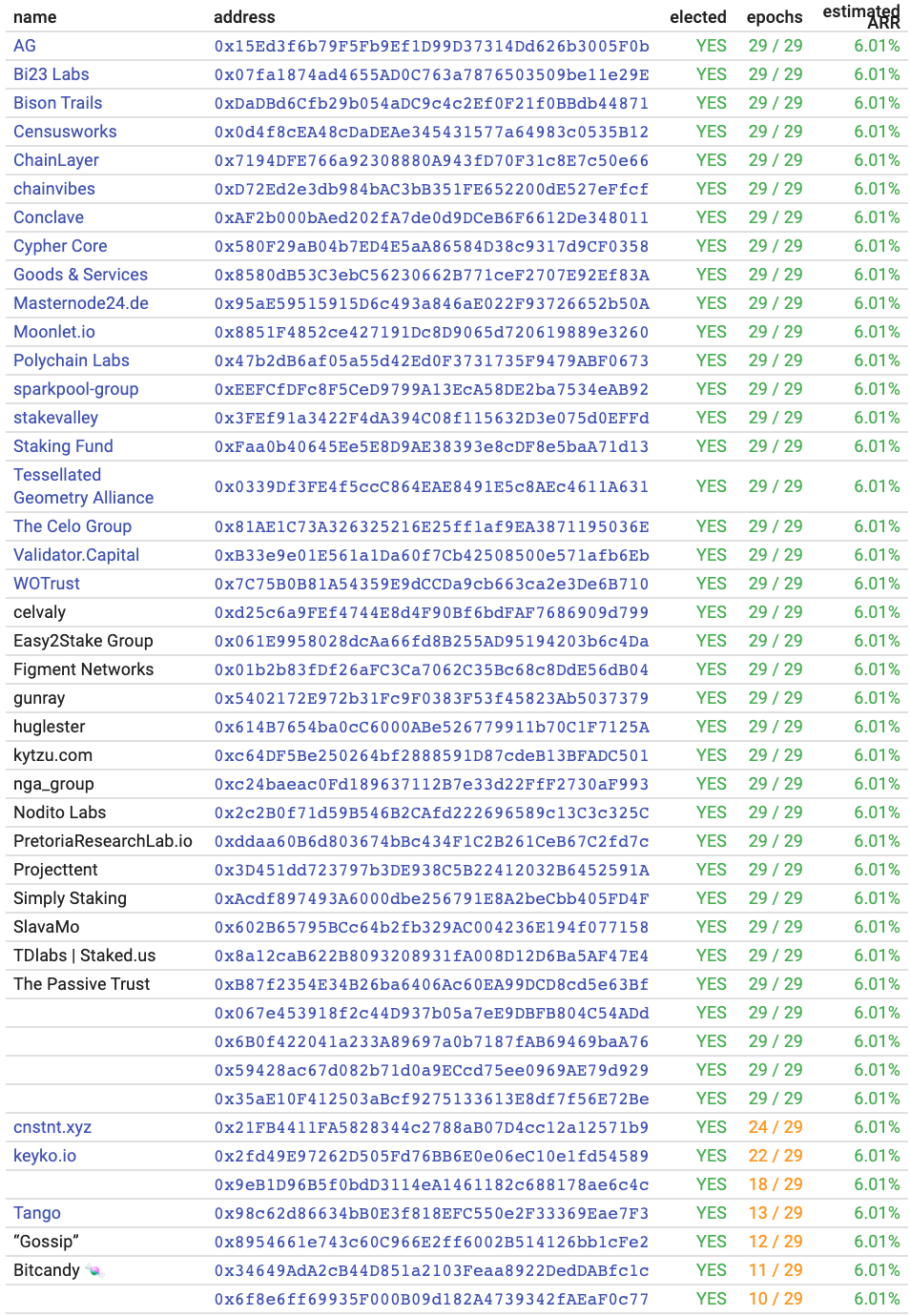May was an exciting month for Celo. Release candidate network has been declared as main-net and its tokens have officially started trading on external exchange platforms.
Election Overview
Now that the first month is over, its time to take a look back and see how Celo’s validator groups are doing. First, we will start with some general statistics.
Celo release candidate network started with 49 “genesis” validator groups. Once network was bootstrapped, even more validator groups got created. Currently there are total of 62 groups that have at least one validator elected.

Elected validator groups
More interesting has been the increase in minimum votes required to elect a single validator. Requirements started out at a modest 150-200k votes per validator, however, after the Coinlist auction there has been a rapid increase in minimum requirement. Over the last week, required votes to elect a single validator has stabilized at ~1.4 million votes. It is likely that the requirement can continue to increase as cGLD tokens become available on more exchanges and as its overall liquidity and availability increases. High requirement for electing a validator is a good sign for Celo. Proof-Of-Stake protocols can not be secure or stable if there is nothing of real value at stake.

Minimum votes required to elect single validator
Uptime Overview
Another important aspect for stability of Celo’s Proof-Of-Stake protocol is the stability and performance of its elected validators. In this section, we will dive into uptime of elected validators over the last month. Before we go over the uptime numbers, it is useful to first develop basic intuition of how the uptime affects voter rewards that Celo gold holders get.
Voter rewards multiplier is currently set to 1.00016, meaning that if a group has perfect uptime, its’ voters get their locked and
voting gold multiplied by 1.00016 every epoch (1 epoch is ~1 day). Since 1.00016 ^ 365 = 1.0601340141 this leads to target 6.01% annual
returns for voting gold, assuming everything goes perfectly for the voted group. To develop some basic intuition on how the uptime
affects voter rewards, it is useful to look at few example scenarios of what the annual returns would be in various outage cases.
Examples of annual rate of returns (ARR) for a Group with single validator that has consecutive downtime of X minutes every 30 days:
X = 30 minutes, ARR ->5.975%X = 60 minutes, ARR ->5.942%X = 4 hours, ARR ->5.84%X >= 8 hourswould lead to slashing, thus it would cause the ARR to drop below3%
As you can observe, ARR drops below 5.95% require either single very serious outage, or multiple small outages to happen in a 30
day time period. This is good news for the voters. Even if the voted group can’t maintain perfect uptime, as long as they are not
receiving slashing penalties, they are likely going to be pretty close to the target 6% annual returns.
Now that we have some basic understanding of how uptime affects voter rewards, we can take a look at how validator groups
performed over the last month. We will use Estimated ARR data from Celovote. Most groups had perfect
or close to perfect uptime and they have maintained their estimated ARR at ~6.01%.

Snapshot of Estimated ARRs from https://celovote.com/scores
Moving towards the bottom of the list, we see groups that have estimated ARR in range of 5.95% - 6.00%. These groups had some issues,
but nothing too major, most likely keeping any consecutive downtime to less than 30-60 minutes. It is expected that as more time passes,
almost all groups will have at least some sort of a minor issue, thus there isn’t too much to read into for slight drops in estimated
ARR.

Snapshot of Estimated ARRs from https://celovote.com/scores
Moving further down, there were total of 10 groups at the very bottom, that have had at least one large issue over the
past month. Out of these 10, 2 groups in particular (Chorus One, and Chainflow) had large enough downtime to qualify for
downtime slashing.
Luckily, slashing does not work in main-net yet,
thus their voter rewards have not taken as big of a hit as they would have otherwise.

Snapshot of Estimated ARRs from https://celovote.com/scores
Since Celo network is still very new, it is a bit too early to read too much into the overall uptime and performance for different validator groups. There is going to be natural “operational luck” this early in the process. More time needs to pass before estimates based on the past performance can become more accurate predictors of the actual performance in future.
Wrap up
Overall, Celo network is looking healthy. Proof-of-stake protocol seems in good shape with quite a lot at stake behind each elected validator, and network health seems in good condition due to strong cohort of validators with low downtime and solid performance.
We are looking forward to take part in continued growth of Celo network, and plan to provide monthly validator round ups going forward.


